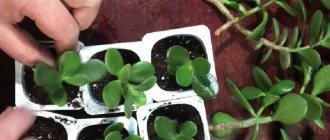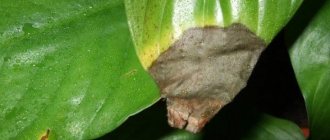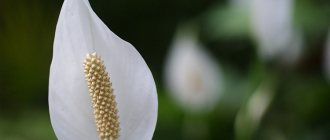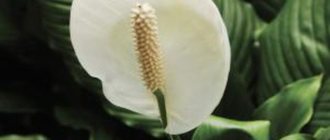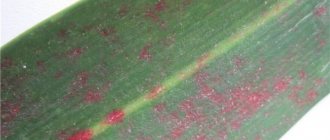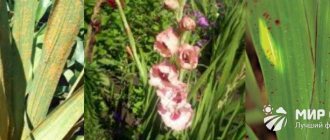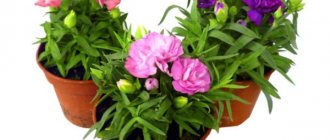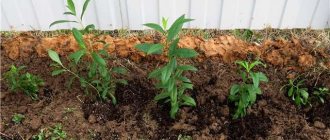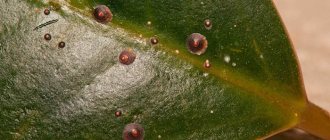What most often affects the plant?
- Lack of growth - excessive soil moisture or excess sun rays.
- Brown spots on the foliage are a sign of pest damage or excessive moisture. Lack or abundance of moisture leads to the appearance of black tips.
- Blackness on the surface of the leaf blade means a low content of nitrogen, phosphorus, and potassium.
- Dry tips on a young plant indicate that it is adapting to new conditions.
- If a formed bush suffers , change watering, making it frequent.
- Lack of flowering - transplantation into an overly large pot occurred, which led to the growth of the root system, instead of throwing out flower stalks.
If the transplant was not carried out, and there are still no buds, you need to place the pot on the balcony for 2 weeks and maintain the temperature at least 12-13 degrees. - Curling leaves are a sign of a cold room. The optimal temperature for this family is +18…+24 degrees.
- Loss of flower brightness and wilting is often associated with root rot.
Diseases of the leaves of Women's happiness
The most common leaf diseases of spathiphyllum are chlorosis and gommosis (Fig. 3). Plants are most often affected by chlorosis in the autumn-winter period, when it is quite cool on the windowsill. Some gardeners adhere to the same watering regime in autumn and winter, forgetting to measure the ambient temperature. This is when a disease called chlorosis creeps up. Also, this disease can occur against the background of existing root rot or damage to the roots as a result of flower transplantation. If the plant is overfed or lacks nutrients, then all this is reflected in the leaves - they begin to wither and turn yellow.
When foliage begins to wilt under the influence of harmful bacteria, this condition is called plant gommosis. The leaf blades of spathiphyllum begin to gradually turn black at the edges. The disease is dangerous for other flowers, and not just for Women's Happiness. The affected leaf blades, which are no longer so green, should be removed; the remaining healthy leaves should be washed with laundry soap in running water at a temperature of 22-24 °C.
In addition to bacteria and fungi, spathiphyllum can be attacked by insect pests.
Scale insects settle not only on spathiphyllum, they can infect all plants in the house. Therefore, you need to get rid of the pest urgently. Adult insects no longer become motionless, and young individuals are able to move. This is how infection of one plant from another occurs (Fig. 4). How to save a plant from scale insects? This pest can be destroyed using a soap solution. If this does not help, then you can use a tobacco solution. Adult insects can be removed from the plant with a cotton pad soaked in kerosene or alcohol solution. Scale insects are quite difficult to get rid of. The infected plant can be rubbed with garlic juice or olive oil mixed with water using a brush. Add 4-5 tbsp to 1 liter of water. l. olive oil and applied to the plant daily for 10 days. Constant ventilation is also required. If the measures taken do not help, then you will have to fight with the help of chemicals.
Another dangerous pest of the vegetative part of the plant is the spider mite. It is easy to recognize by the cobwebby coating on the leaves. You can remove it from the surface of the plant in the same way as scale insects - with a soap and tobacco solution. Treatment must be started immediately to prevent other indoor plants from becoming infected.
How to save spathiphyllum from fungal and insecticidal diseases? You can also dust the plant with sulfur powder. Sulfur helps in the fight against insect pests such as spider mites and scale insects. Sulfur is also a strong fungicide; it can destroy some types of fungi that infect the White Sail.
When and what should be treated, how to do it?
Urgent resuscitation is done when previous efforts have not produced a positive effect and the pet’s condition is worsening every day.
Black leaves, delayed flowering, a dark-colored root system, withered crown of young shoots, stunted growth - these are clear signs of a dying bush. How to cure a plant?
The rescue goes like this::
- The spathiphyllum is removed from the pot and the rotten roots are cut off.
- Intact roots are washed with potassium permanganate. After this, they are treated with activated carbon and wrapped in newspaper for a day.
- While they are drying, a container with new soil is prepared. The soil is poured into the pot after drainage holes are made and a drainage layer is laid.
- Next, the flower is transplanted into new soil.
- Immediately after transplantation, watering is not performed. The top of the spathiphyllum is covered with plastic film or a plastic bottle, creating a greenhouse effect.
Treatment method
Aloe diseases: causes of diseases and their treatment options
Various diseases, the treatment of which is often not sufficiently effective, are always easier to prevent than to overcome. Chlorosis and late blight are so dangerous that the plant has to be destroyed to prevent an epidemic.
Description of the main methods of treating diseases of the “female happiness” flower:
- If the flower does not grow, you should transplant it into a container with a smaller diameter and expose it to light.
- Yellow leaves are a sign that the plant lacks chlorophyll and requires fertilizing with iron chelate, otherwise chlorosis will develop.
- The only way to fight rot is to transplant it into a new flower pot.
However, most spathiphyllum diseases cannot be treated at home and lead to the death of the green pet. The only exception is if their cause is a violation of cultivation technology, then it is enough to start properly caring for the crop.
How to prevent the problem from happening again?
- Carry out regular inspection of the flower.
- Fertilize with Fitoverm.
- Do not use a sprayer with large openings.
- Maintain optimal room temperature.
- Spray with water in winter and autumn to combat dry air masses.
- Water as the soil dries out.
- Feed with complex fertilizers once every 30-45 days.
Spathiphyllum does not often suffer from illnesses . His illnesses in most cases are the result of improper care. If you notice the blackening of the leaves in time and identify the cause of this condition, the plant can be saved.
Diseases of the spathiphyllum root system
Root aphids, or root worms, love to eat the roots of spathiphyllum. If a cotton-like white or grayish coating appears on the walls of the pot or the surface of the soil, this means that aphids have infested the roots. In the photo the pest looks like this (Fig. 1). The pest can appear in a pot due to improper care and contaminated soil. Before planting a flower, it is best to treat the soil against insects. Aphids settle on the roots, which are responsible for absorbing moisture and nutrients from the soil, so the White Sail begins to wither and wither, and the leaves become less green.
If the spathiphyllum is watered in insufficient or excessive quantities, an excellent environment for the proliferation of root aphids is created. You can fight it if you water the flower 1-2 times a week with a weak solution of potassium permanganate.
If the flower begins to lose the brightness of the leaves, and then completely fades without visible external damage, then the roots have been affected by root rot. In this case, the plant must be replanted, carefully removing the rotten roots. After removing the rotten parts, the roots are treated with Glyokladin. Rotting is promoted by frequent watering, too dense or excessively wet soil, as well as soil with low acidity. Rot is caused by fungi. The flower needs to be watered less.
As the rot progresses, the leaves become discolored, then turn yellow and wither (Fig. 2). The affected roots of spathiphyllum acquire a red-brown tint. When fungal spores fall on the vegetative parts of Women's Happiness, the leaves become covered with brown spots. Infected leaves should be removed to avoid infecting neighboring plants.
Another dangerous fungus for plants is phytospore. It causes root blight and leaf spot. The roots soften and slowly die, leaving the plant without nutrition. Do not allow water to stagnate in the pot. The next watering should be done only when the top layer of soil dries out.
What to do if the leaves become lighter?
To save “women’s happiness,” the florist must perform the following steps::
- Normalize watering. The soil is moistened only after 1/3 of the total volume of soil has dried out. And at the same time do not allow the soil to dry out. For irrigation, take settled water at room temperature.
- Spray the crop daily to maintain optimal air humidity levels.
- The air temperature in summer and spring should be 25-27 degrees, and in autumn and winter – 15-18 degrees.
- During the period of active plant growth, feed it regularly (once a week), using ready-made mineral complexes for this.
- To combat diseases, treat spathiphyllum with a fungicide, and use insecticides to kill pests.
Spathiphyllum does not grow
If you are new to indoor floriculture, and you were given a spathiphyllum, home care for you will be to ensure that the plant does not stop growing and new leaves appear. At first, this is what happens - there will be vigorous growth and you will have a desire to plant the plant, but then the flower will no longer want to grow.
Spathiphyllum does not grow among amateur gardeners for only two reasons:
- Large pot - its diameter is much larger than the plant needs.
- Transplanted plants are exposed to too bright sunlight or, conversely, removed into deep shade.
What to do if spathiphyllum does not grow:
1. We always replant the plant in a pot that is not much larger than before. If the sprouts are planted in several pots, then they are taken with a very small diameter and low. Please note that if the flower container is much larger, then new green leaves will not grow for very long until the roots grow and entangle all the soil in the pot.
2. Keep the flower in a place that is comfortable for it - in a fairly bright place, but without direct rays of the sun.
Prevention
Preventive measures consist of the simplest measures:
- Humidity level maintenance.
- Position the plant in such a way that it receives only diffuse sunlight.
- Regular watering and fertilizing (without exceeding the recommended dosage).
- When parasites or diseases appear, the crop is treated with special means and transplanted into new soil and a flowerpot.
Failure to follow the rules of care can lead to problems with growing “female happiness” and loss of its decorative value. The florist should respond to changes quickly and competently.
Spathiphyllum diseases with photos and their treatment
Spathiphyllum or women's happiness pleases with snow-white flowers and bright greenery. But what to do if the flower begins to fade or turn yellow? In the article I will tell you what diseases of spathiphyllum can cause the death of the plant.
Pests of indoor flowers
The damage to a flower by insect pests is immediately noticeable - characteristic signs form on the leaves, the plant begins to wither, and in the absence of specific treatment, it may die.
Spathiphyllum is a “delicacy” for many insect pests, but most often it is susceptible to the negative effects of aphids, spider mites, and mealybugs.
Spider mite
One of the most dangerous pests for indoor plants is the spider mite. Insect pests can be detected by the appearance of a characteristic thin cobweb on the lower leaves of the plant. Parts of the leaf covered with cobwebs begin to wither over time.
It is necessary to use certain measures to control spider mites immediately. If a pest “entangles” the entire plant in a web, it will be almost impossible to cure it.
To destroy spider mites, the flower is washed or sprayed with special solutions. A concentrated soap solution produces good results.
To prepare it, you need to grate half a piece of laundry soap on a fine grater, mix the resulting shavings with 1 glass of warm water, bring the composition to a homogeneous mass and thoroughly rinse the affected plant structures with the prepared soap solution.
Another effective remedy against spider mites is a decoction of onion peels. To prepare the composition you need 500 ml. Boil water with 1 cup of onion peel. Let the prepared mixture sit for 24 hours and treat the affected plant.
If the spathiphyllum is severely affected by spider mites, then it is recommended to use insecticides to destroy the pest - Antimite, Akarin, Fitoverm, Neoron.
Aphid
Another common spathiphyllum pest is aphids. This tiny insect forms colonies that infect the leaves and stems of the plant. The insect feeds on the sap of the flower; large colonies of aphids can destroy the flower.
Aphid pests can be identified by certain signs:
- small green insects appear on the leaves;
- the affected plant structures dry out, wither, and curl.
Aphids are characterized by active fertility, so if even one or two insects are detected, appropriate action must be taken immediately. Elimination of aphids is carried out with insecticidal preparations - Fitoverm, Aktara, Aktellik, Decis.
To completely destroy a harmful insect, several treatments are required (at least 2). During the procedure, care must be taken to ensure that the chemical composition does not get on the soil. To do this, before spraying the plant, cover the pot with plastic wrap.
Mealybug
The cause of mealybugs is increased soil moisture. The pest “gnaws” the roots and leaves of the plant, provoking the development of the following signs - the leaves wither, dry out, the plant becomes lighter, and the root system begins to rot. With extensive damage to the mealybug, spathiphyllum can die.
To eliminate insect pests, the following means are used:
- decoction of citrus peels - brew the peels of 1-2 tangerines in 1 glass of boiling water, thoroughly rinse all the structures of the flower with the resulting mixture;
- alcohol solution - early pest damage can be eliminated by wiping the plant with an alcohol solution;
- insecticides - Aktellik, Aktofit, Aktara, Mospilan.
Sooty mushroom
Infection of spathiphyllum with a fungal infection is very dangerous; if timely treatment is not started, the plant may die in the shortest possible time. Signs of damage are blackening of the upper leaves of the flower, darkening of the leaves and trunk.
Measures to combat sooty fungus consist of treating the affected spathiphyllum. In the early stages of damage, you can use a concentrated soap solution; in case of heavy damage, insecticides (Aktara, Horus, Decis, Sherpa).
Shchitovka
A dangerous pest for spathiphyllum is the scale insect. The insect is difficult to see because its size is microscopic. The development of the disease may be indicated by the following signs: the appearance of small dark spots on the leaves and stem of the flower. The insect feeds on the juicy pulp of the plant, and accordingly, the affected flower structures begin to dry, wither, and curl.
In the initial stages of defeat, the fight against scale insects is carried out using folk remedies. To do this, you can use a tobacco-soap solution or kerosene. Preparation of tobacco-soap solution - 500 ml. Boil 2 tbsp water. spoons of tobacco dust, cool the composition and add 1 tbsp. spoon of soap shavings.
Only insecticides - Fitoverm, Actofit, Inta-Vir, Actellik - can cope with severe damage to harmful insects.
Spathiphyllum diseases
Insect pests are not always the cause of wilting of an indoor flower. Spathiphyllum is often affected by certain diseases, which lead to corresponding changes - lack of flowering, darkening of the tips of the leaves, and even the death of the plant.
Treatment of the disease begins only after the root cause of the development of the corresponding changes has been identified.
Slow growth
The cessation of growth in spathiphyllum is observed only for 2 reasons:
- placing the flower in places with bright sunlight or, conversely, in deep shade;
- The pot is too big and voluminous.
You can stimulate the growth of indoor flowers with proper care. Firstly, it is important to remember that the plant needs timely replanting. The overgrown spathiphyllum is divided into several parts, each of which is placed in a shallow pot. Proper planting of the plant will ensure its active development and growth.
Yellowness of leaves
If the bright green leaves of spathiphyllum begin to turn yellow, this may be due to the following reasons:
- the flower is exposed to sunlight and the leaves are burned;
- the plant is located on the sunny side, its discoloration occurs;
- spathiphyllum needs feeding;
- natural aging of leaves.
Plant lethargy
If the flower begins to fade, then you need to worry about timely watering. But moisture deficiency in the soil does not always cause the lethargy of spathiphyllum. The flower also fades due to waterlogging of the soil. In this case, the root system rots and, accordingly, the plant begins to hurt.
Dry leaf tips, dark spots
The formation of yellow or black spots on the tips of leaves always indicates improper care. The following reasons lead to an uncomfortable state:
- Excessive dry air (especially in winter). Spathiphyllum needs high air humidity. To achieve this, the flower is regularly sprayed or the container is placed on a tray with moistened expanded clay.
- Overflow of a flower. Rotting of the root system as a result of overwatering can lead to the death of the plant. Spathiphyllum cannot be flooded; it is important to organize regular and moderate watering.
- Freezing of roots. If the pot is placed on a cold windowsill, the roots of the plant freeze, resulting in dark spots forming on the leaves.
- Leaf burn. Blackening of the leaves can cause burns. This can happen as a result of unintentional application of fertilizers to the leaves of the flower.
No flowering
Spathiphyllum is an actively flowering indoor plant. The absence of regular flowering indicates a certain discomfort that the flower has encountered. What most often leads to a houseplant not blooming?
- Lack of lighting. The flower does not tolerate dark rooms well. But this does not mean that the plant must be left in a place where it will be constantly exposed to bright sunlight. For comfort, spathiphyllum is placed in partial shade.
- Uncomfortable potty. Spathiphyllum develops poorly and, accordingly, blooms in wide and too high containers. Active flowering begins after the roots of the plant completely entwine the soil inside the pot. If the plant is planted in a large pot, then full flowering can be expected for about 5 years, that is, until the roots occupy most of the pot.
- Poor soil. The plant needs regular feeding. If the soil in the pot is poor and devoid of nutritional components, then the flower begins to ache, wither, and does not bloom regularly.
- Oversaturation of the soil with mineral components. Excessive application of fertilizers to the soil also negatively affects the condition of the plant. Lack of flowering is observed if the soil is oversaturated with nitrogen, but lacks potassium and phosphorus.
Greening of flowers
If the spathiphyllum flowers were rich white but began to turn green over time, then this is not a cause for concern. Greening of flowers only indicates that the plant has faded.
Conclusion
- Pests are the main danger to spathiphyllum. To eliminate negative consequences, it is important to provide the plant with timely treatment.
- Changes in the development of a flower indicate the onset of a disease, which is always provoked by certain reasons.
Source: https://sornyakov.net/komnatnye/bolezni-spatifilluma.html
Why do spathiphyllum leaves dry out and turn yellow?
Why do the leaves of spathiphyllum lose their natural color, turn yellow and dry out the tips, and what to do about it?
Yellowness instead of green foliage is fraught with many reasons. Fortunately, this trouble can be dealt with and the flower can be brought back to life. The main thing is patience and work, and most importantly, to establish the reason why the leaves turn yellow. This will allow you to understand how and what to do to save spathiphyllum.
There are many reasons for yellow spathiphyllum leaves:
- Pot too big;
- Low temperature;
- Excessive dryness or humidity;
- Lack of vitamins and minerals, when fertilizing is needed, which must be carried out 2-3 times a year;
- Lots of shadow, little light.
- Lots of sunshine;
- Oddly enough, the old age of the flower also plays a big role. Planting a flower is the only way to save it;
- The room is very cold or very hot, that is, the temperature in the room should be 20–25 degrees, no more and no less;
- Excessive watering or lack of moisture;
- Lack of systematic spraying of the ground part of the plant;
- Excessive or incorrect trimming of flower shoulder straps.
Depending on the variety of spathiphyllum, the flower varies from light green to cream color.
Description of the manifestations of the problem and photos of the affected areas
A disease that affects the leaves of spathiphyllum can manifest itself as their gradual wilting and further yellowing.
Sometimes you can see pale yellow or brown spots, which then dry out and fall off (why do spathiphyllum leaves and their tips dry out?). Also, the disease can only affect the tips of the leaves: they become dry and brown (why does spathiphyllum dry out?). The symptoms of two or more causes may be similar, so the process of identifying the main one may take some time and require patience.
Mealybug
We recommend reading our other articles
- How to plant potatoes
- Survive the holiday!
- What kind of house flowers are useful to keep in the house?
- Wood Bee parquet board
Mealybug loves moisture, so it only attacks those spathiphyllums that are constantly overwatered. Pests hide between the leaves.
You can wipe the leaves with a cloth soaked in alcohol and mechanically remove all pests. I like the method of drying the soil a little (do not water) and placing half of the cut potatoes on the ground.
Pests love dampness very much, so they will run under it like a fungus, then throw it away. If all else fails, you will have to treat with the drug.
